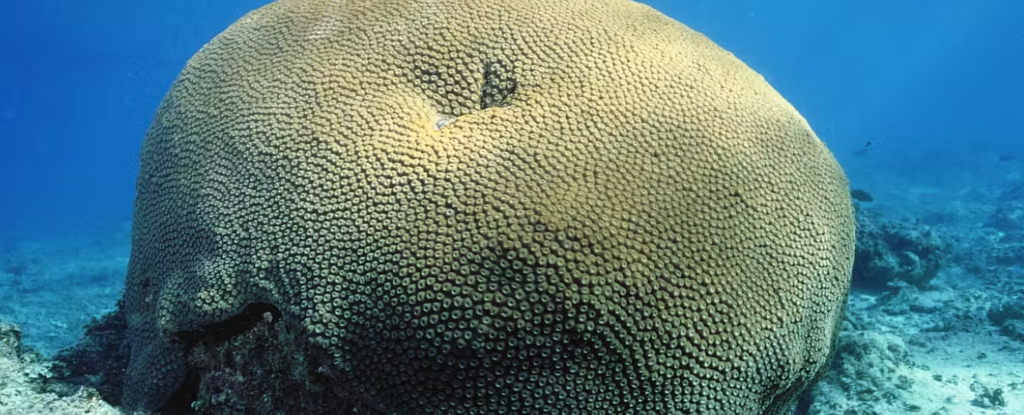A single coral on the Fiji Islands that is over 600 years old was used to record how temperatures in the Pacific Ocean have changed during its long life.
Scientists know that the Pacific Ocean has generally warmed over the centuries, and in recent years human-caused climate change has led to marine heat waves and widespread coral bleaching.
But it is believed that there have been cooler and warmer years – and even decades – over time. Of course, it is hard to know much about this variability because there are very few continuous records going back hundreds of years.
Our research, now published in Scientific advanceshelps to fill these gaps. We used a sample from a single, huge Diploastrea heliopora Coral, also known as honeycomb coral. This unusually old specimen was discovered in 1998 and scientists took a sample by drilling into it. We have now analyzed this sample using modern scientific techniques.
We have combined these long coral records with those of other corals in the Fiji archipelago to create an overall chronology of temperatures in Fiji’s waters. For the period since the 1990s, we have a wealth of data from weather buoys, satellites and other instruments that we can combine with this.
This means that the coral records technically span 627 years and can tell us what the sea temperature around Fiji was between the years 1370 and 1997. It is the longest continuous temperature record of its kind anywhere in the tropical ocean.

Corals can be a window into the past
Massive corals can live for many years, continually building a skeleton of calcium carbonate that builds up in layers on top of the old skeleton. The living part of the coral occupies only the top few millimeters. As new layers are added, the old skeleton is exposed by the coral, leaving a record of past conditions.
In particular, we looked for the ratio of two elements in the coral skeleton: strontium and calcium, which serve as an indicator of seawater temperature. If there is less strontium than calcium in the coral skeleton, it means that the water was warm when the coral was alive, and vice versa.
We analyzed these elements using mass spectrometry instruments that quantify the elemental composition of materials even at very low concentrations.
Temperature data from corals show how climate patterns such as the Pacific Interdecadal Oscillation have evolved over centuries and provide important frameworks for understanding current and future climate trends.
The Pacific Ocean is a major driver of climate variability around the world, most famously the Pacific Ocean’s shift from El Niño to La Niña conditions every few years, when temperature fluctuations in the ocean lead to large swings in rainfall amounts and the development of hurricanes.
But even this cycle is kept in check by the interdecadal oscillation, which brings a temperature difference between the northern, southern and tropical Pacific every 15 to 30 years.
Modern warming in context
Giant rocky corals can contain centuries-old stories in their growth history or the chemical composition of their skeletons. For example, the coral suggests that there was a notable warm period between 1370 and 1553, when the sea around Fiji was almost as hot as it is today. This highlights how the Pacific climate system naturally varies.
However, we can combine our corals with other paleoceanographic records from across the Pacific to get the bigger picture, and find that the Pacific warming of the last century, which is largely attributed to human-caused global warming, represents a significant departure from the natural variability recorded in previous centuries.
While some parts of the Pacific were warmer in the past, while others were cooler for a decade or two, and vice versa, this relationship is now breaking down. Warming is increasingly synchronous in the tropical and subtropical Pacific.
This in turn leads to large shifts in precipitation amounts and drought and flood cycles, since rain is often caused by the evaporation of water vapor over warmer seas.
But this warming, characterized by a relatively small difference in ocean temperatures in the Pacific, is not typical for the past six centuries. This suggests that Pacific warming since the early 20th century may be leading to unprecedented changes in the interdecadal oscillation.
Impacts on the future climate
Understanding the long-term behavior of the Pacific Interdecadal Oscillation is crucial for predicting future climate change.
A recent study of corals in Australia’s Great Barrier Reef and the surrounding Coral Sea found that reef temperatures during five coral bleaching events were the highest in the last 407 years. The world’s largest reef is in grave danger.
Our own research shows that the sea around Fiji is hotter than it has been for at least 653 years. These changes could lead to more extreme weather conditions, such as longer droughts or more intense tropical cyclones, with significant consequences for the millions of people who live in the region.
Our study shows why long-lived giant corals are so important as archives of past climate change, but their future is threatened by warming oceans. Protecting these giant corals is vital.![]()
Juan Pablo D’Olivo, Principal Investigator, Institute of Marine Sciences and Limnology, Universidad Nacional Autónoma de México (UNAM); Ariaan Purich, Lecturer in Climate Variability and Change, Monash University, and Jens Zinke, Professor of Paleobiology, University of Leicester
This article is republished from The Conversation under a Creative Commons license. Read the original article.

